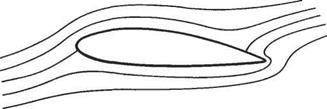The vortex system
![]() Lanchester’s contribution was essentially the replacement of the lifting wing by a theoretical model consisting of a system of vortices that imparted to the surrounding air a motion similar to the actual flow, and that sustained a force equivalent to the lift known to be created. The vortex system can be divided into three main parts: the starting vortex; the trailing vortex system; and the bound vortex system. Each of these may be treated separately but it should be remembered that they are all component parts of one whole.
Lanchester’s contribution was essentially the replacement of the lifting wing by a theoretical model consisting of a system of vortices that imparted to the surrounding air a motion similar to the actual flow, and that sustained a force equivalent to the lift known to be created. The vortex system can be divided into three main parts: the starting vortex; the trailing vortex system; and the bound vortex system. Each of these may be treated separately but it should be remembered that they are all component parts of one whole.
5.1.1 The starting vortex
When a wing is accelerated from rest the circulation round it, and therefore the lift, is not produced instantaneously. Instead, at the instant of starting the streamlines over the rear part of the wing section are as shown in Fig. 5.1, with a stagnation point occurring on the rear upper surface. At the sharp trailing edge the air is required to change direction suddenly while still moving at high speed. This high speed calls for extremely high local accelerations producing very large viscous forces and the air is unable to turn round the trailing edge to the stagnation point. Instead it leaves the surface and produces a vortex just above the trailing edge. The stagnation point moves towards the trailing edge, the circulation round the wing, and therefore its lift, increasing progressively as the stagnation point moves back. When the stagnation point reaches the trailing edge the air is no longer required to flow round the trailing edge. Instead it decelerates gradually along the aerofoil surface, comes to rest at the trailing edge, and then accelerates from rest in a different direction (Fig. 5.2). The vortex is left behind at the point reached by the wing when the stagnation point
|
|
|
reached the trailing edge. Its reaction, the circulation round the wing, has become stabilized at the value necessary to place the stagnation point at the trailing edge (see Section 4.1.1).[22] The vortex that has been left behind is equal in strength and opposite in sense to the circulation round the wing and is called the starting vortex or initial eddy.













